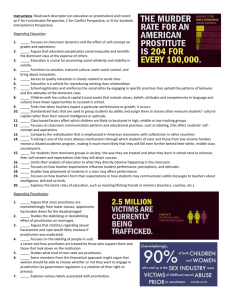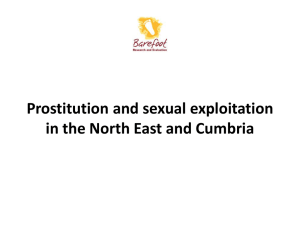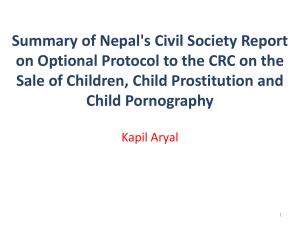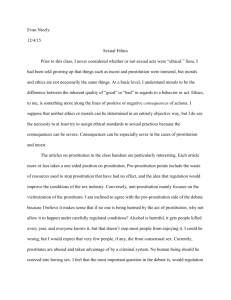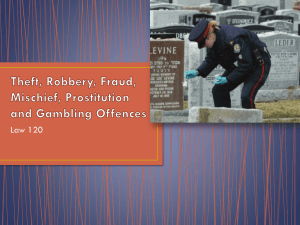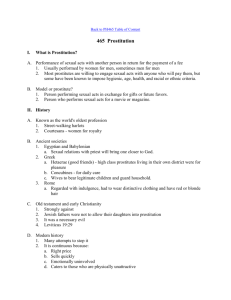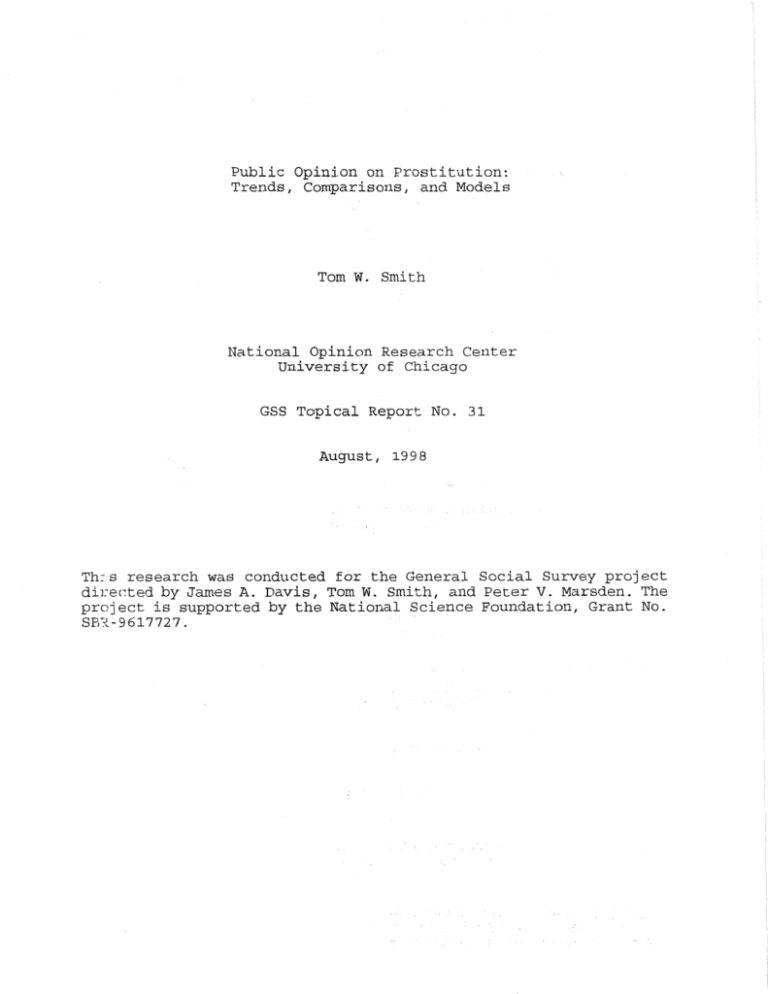
Public Opinion on Prostitution:
Trends, Comparisons, and Models
Tom W. Smith
National Opinion Research Center
University of Chicago
GSS Topical Report No. 31
August, 1998
This research was conducted for the General Social Survey project
dii~ectedby James A. Davis, Tom W. Smith, and Peter V. Marsden. The
project is supported by the National Science Foundation, Grant No.
SEX-9617727.
Introduction
Since the so-called sexual revolution of the 1960s, sexual
attitudes have undergoing complex and varied changes (Smith, 1990;
1994; 1996). Rather than uniformly moving in a permissive
direction, the public views on sexual morality have moved in
different directions, at different rates, and during different
periods. For example, approval of premarital sex increased from the
1960s to the early 1980s and has showed little variation since,
favorable views of homosexual sex grew only in the 1990s, and
acceptance of extramarital sex actually declined over the last
three decades. In addition, attitudes vary considerably from topic
to topic. For example, while only 24% consider premarital sex
"always wrong," 70% consider it such if it involves teenagers.
Thus, to understand how sexual morality in general has changed
and what is approved of or rejected, one must specifically examine
all facets. One important aspect about which little is known is
public attitudes towards prostitution. While selling sex may be the
world's oldest profession, research on public opinion regarding the
practice and the laws regulating it are sparse (Weitzer, 1991; see
also Milman, 1980). To help fill this void, this paper examines 1)
attitudes toward prostitution, 2) trends in attitudes, 3) how
evaluations of prostitution and prostitutes compare to other
activities and groups, and 4) what socio-demographic factors shape
attitudes towards the selling of sex.
Attitudes towards Prostitution
The public has generally been opposed to prostitution. First,
over the last 20 years the public has typically rejected legalizing
or decriminalizing prostitution (Tables 1 and 2). However, the
level of support has varied considerably depending on how the issue
is presented to the public. Support is greater when 1) positive
rat:j.onales are presented (e.g. I1to help reduce the spread of
AIILS~~),2) the scope of prostitution is limited (e-g. "under
certain restriction^,^^ "limited...to just one district in any city
or towntr)
, 3) potential negatives are discounted (e.g. "health
risks minimizedu and between "consenting adultsu), and 4) partial
approval is permitted (e.g. "agree partly," "allowed, but regulated
by law"). Support is reduced when 1) it's scope is not limited
(e.9. "legalizing prostitution throughout the United Statesn) and
2) it is described as coming close to the respondent (e.g. "in your
state"). When one or more of the enhancing situations apply,
support is typically about 40-55%. Questions with no enhancers or
a cegative factor mentioned usually find about 22 - 29% approving of
prostitution's legalization.
Second, a plurality of the public
(38-49%) considers
prostitution to a be major problem although almost as many (31-36%)
rate it as only a minor problem (Table 2). Similarly, a plurality
(42-47%) says that it is "very importantM that laws against
prostitution are strictly enforced while another fifth find this
"fairly importantv (Table 2).
Third, few see prostitution as beneficial to the country. 6064% say it is "never justifiedu and the percent considering it
"harmfulu outnumbers the share feeling it is whelpfulnby from 5 to
17-to-1 (Table 2).
Fourth, in terms of how the law treats prostitution, most
people favor the status quo. Only 12% think that prostitutes are
treated unfairly by the law and another 16-23% think they are
treated too leniently (Table 2). As for their customers, two quite
different questions each found about half supporting the
publication of the identities of "johns" (Table 1).
Trends
Available time series concerning prostitution are limited in
terms of the number of trends, the span of years covered by most
trends, and the number of observations per trend (Table 1).
Approval of prostitution seems to have increased modestly in the
1970s. Then, support for prostitution generally declined in the
1980s and 1990s, except for one series showing an increase between
1981 and 1990 from 36% to 40% saying prostitution is sometimes
justified.
Compared to What
In numerous surveys during the last 30 years prostitution or
prostitutes have been implicitly compared to other activities and
types of people. Table 3 summarizes the most frequent comparisons.
While the position of the selling of sex vis a vis other behaviors
depends on the date of the survey, the exact way the targets being
ev~luated are described, and the basis of the evaluation, the
general standing of prostitution can be ascertained from these
comparisons. Overall, prostitution is considered
1) more negatively than: abortion, adult, heterosexual sex,
and gambling.
2) more
positively than: atheism, extramarital
pornography, and youthful sex (by a slight margin).
sex,
3) sometimes more negatively and other times more positively
than the following:
a) Alcohol - more negatively than social drinking, but
more positively than alcoholism.
b) Drugs - more negatively than as a topic for school
discussion and for the private use of marijuana, but
generally more positively than soft or hard drug use and
especially more positive than drug addiction.
c) Homosexuality
earliest years.
-
more
positively, except
in
the
d) Smoking - more negatively as a subject for school
discussion and object for law enforcement, but more
positively in that smoking is seen as a greater problem.
Among the many other comparisons prostitution/a prostitute is
considered as less serious/wrong/harmfu1 than a polluting factory,
members of the American Communist party, hippies, welfare cheats,
tax cheats, sexual harassers, having a child outside of marriage,
riding a motorcycle without a helmet, illegal campaign
contributions, drunk driving, and crooked lawyers. It is considered
more serious/wrong/harmful than student demonstrators, working
mothers, students more interested in sports than studies, divorce,
keeping found money, interracial marriages, civil rights protests,
euthanasia, and beatniks.
Second, a major study that had people evaluate the seriousness
of a large number of crimes showed that on average people
considered prostitution to be a minor crime (Wolfgang, et al.,
1985). As the selective crimes reported in Table 4 indicate, a
murder during a robbery is rated as over 20 times as serious and a
simple assault or a mugging without physical harm are considered
about 3 times as serious as being a prostitute. Table 4 also
inc?icates that both pimping and running a house of prostitution are
rated about 3 times as serious as being a prostitute (and thus
about as serious as a simple assault or minor robbery). Engaging in
prostitution is considered about as serious as minor shoplifting.
Bejn3 the customer of a prostitute is rated as being a slightly
less serious crime than being the seller.
In general, this indicates that the evaluation of
p r : ) s t i t u t i o n / p r o s t i t u t e s is in the middle range of approval
co~npared to other suspect practices and groups. First, in the
sexual realm prostitution is more critically viewed than adult,
heterosexual sex and homosexual sex (since the mid-1970s) and seen
more favorably than extramarital sex, pornography, or youthful sex
(by a slight margin). Thus, while most people have negative
feelings towards the selling of sex, it is considered as one vice
amsng many and is not as a target of particular condemnation.
Second, in the criminal realm, prostitution is considered a petty
crime, roughly comparable to shoplifting. Running prostitution
(operating a house of prostitution and pimping) is considered much
more serious a crime than the selling of sex by an individual sex
worker and that in turn is thought of as slightly more serious than
being a customer of a prostitute.
Correlates of Attitudes towards Prostitution
The literatures on sexual attitudes in general (Cutler, 1985;
Klassen, Williams, and Levitt, 1989; McClosky and Brill, 1983;
Posner, 1992; Reiss, 1980; Reiss, Anderson, and Sponaugle, 1980;
Smith, 1994) and prostitution in particular (Barry, 1995; Davis,
1993; Miller, 1993; Milman, 1980; Rist, Haggerty, and Gibbons,
1994; Weitzer, 1991) indicate that support for prostitution will be
greater among 1) the following demographic groups: men, members of
more recent cohorts, the unmarried, Blacks, the better educated,
and those from cosmopolitan regions and communities, 2) the secular
and religiously liberal, 3) those with permissive attitudes towards
other sexual activities, 4) those with permissive lifestyles such
as the acceptance of drugs and alcohol, 5) those less for strict
law enforcement, 6) those against government regulations, 7) civil
libertarians, and 8) feminists.'
With only a few exceptions the bivariate analysis in Table 5,
substantiates these expectations. It analyzes results from the 1996
General Social Survey (GSS), an in-person, full-probability sample
of adults living in households (Davis and Smith, 1996) . The GSS
item, already introduced in Table 2, asks:
How much do you agree or disagree with the following
statements?
There is nothing inherently wrong with prostitution, so
long as the health risks can be minimized. If consenting
adults agree to exchange money for sex, that's their
business.
First, looking at the demographics indicates that prostitution
is more accepted by men, the better educated, the unmarriedI2and
those from more cosmopolitan areas (metropolitan areas and the socalled bi-coastal regions (New England, the Mid-Atlantic, and
Pacific)). Approval does not vary by age/cohort, race, or income.
Second, on the religious dimension approval is higher among those
who attend church less often, reject the divine inspiration of the
Bible, belong to theologically liberal denominations, and have no
religion or a weak attachment to a religion. Third, greater
acceptance of premarital sex, teenage sex, extramarital sex,
homosexual sex, and pornography are all related to approval of
prostitution as is having seen an x-rated film in the last year.
Fo~irth,prostitution is more supported by those with liberal values
and permissive lifestyles. It is more backed by those selfidentifying as politically liberal, those feeling that it is more
imgortant for a child to think for oneself than to obey his or her
he National Organization for Women called for the
decriminalization of prostitution in the 1970s. But then a strong
moxrement developed within feminism that condemned pornography and
prostitution as exploiting women. On discussion of the relationship
of feminism to commercial sex see Alexander, 1987; Basow and
Campanile, 1990; Cowan, Case, and Stahly, 1989; McIntosh, 1996;
Shrage, 1994; Smith, 1987.
'Among the married prostitution is more accepted by men in less
than very happy marriage (Married Men who are Very Happy with their
Marriage = 38.5% approve of prostitution vs. Married Men who are
Not. Very Happy = 55.3%, prob. = .OOl). Among married women,
approval of prostitution does not vary by marital happiness (Very
Happy = 27.5% approving; Not Very Happy = 23.6% approving).
pazents, those who favor the legalization of marijuana, and those
who go to bars. Fifth, those who favor more lenient courts and who
oppose capital punishment are more supportive of prostitution.
Sixth, attitudes regarding government regulation have only weak and
variable relationships towards prostitution. Five of nine
comparisons are not statistically significant and among the weak
significant relationships two indicate that the pro-government
group is more pro-prostitution and two indicated the opposite.
Seventh, backing free speech for politically and socially deviant
groups is associated with support for prostitution, but fears of
having privacy compromised by a government data bank has only a
very weak connection. Eighth, those who favor political equality
and non-traditional gender roles for women are more supportive of
prostitution. This is true for both men and women.3
Multivariate Models
Table 6 presents 10 multivariate, multi-regression models
imjolved attitudes towards prostitution. Because of complex subsetting of variables across different forms of the GSS (see Davis
and Smith, 1996 for details) and other item-level non-response, it
is not possible to enter all variables into one equation and the
sample size varies across models.
Model1 is the basic demographic model. It indicates that
approval of prostitution is greater among non-Blacks, men, nonrural residents, bi-coastal residents, and the better educated.
Prostitution attitudes do not vary by age/cohort and does not
differ between big cities and suburbs.
Models2-8 separately look at the seven different hypothesized
factors described above in the bivariate analysis. Each set of
variables are added to the demographics in Modell. In discussing
these, attention will focus on the added variables, not the
relationships
between
the
demographics
and
approval
of
prostitution. Model2 shows that those who attend church
infrequently and those rejecting the divine-inspiration of the
Bible are more approving. Theological orientation of ones
denomination and self-perceived religiousness are not independently
related. Model3
indicates
that
all measures
of
sexual
permissiveness (approval of various sexual behaviors, supporting
the availability of pornography, and having seen an x-rated movie)
arc related to accepting prostitution. Model4 shows that
liberal/non-traditional beliefs are associated with approving of
prostitution. Specifically, approval is great among political
liberals, those supporting the legalization of marijuana, and those
favoring independence vs. obedience in children. Model5 indicates
-
3~en
and women were looked at separately to see if feminist
women were less supportive of allowing prostitution than nonfeminist women. This was not the case, For both genders more
feminist attitudes were associated with more support for
prostitution.
that an anti-law-and-orderstance is slightly related to accepting
prostitution. Model6 confirms the bivariate analysis that found
little connection between general opposition to government and
views on the selling of sex. Model7 substantiates that civil
libertarians are more approving of prostitution than others are.
Finally, Model8 indicates that feminists on both family and
political issues are more in favor of allowing prostitution.
Models9 and 10 include both the demographics and a range of
variables from the seven factors separately analyzed in Models2-8.
These models both find that approval of prostitution is greater
among men, Blacks, and older respondents. Marital status, place of
residence, and education are not related, although the greater
approval of the better educated remains marginally significant in
Model9. Religion is also a factor, but only infrequent church
attendance remains a significant predictor. General sexual
permissiveness is a strong predictor either alone (in Model9) or
along with support for legalizing pornography (in ModellO).
Likewise, support of legalizing marijuana (in ModellO) is
associated
with
accepting
prostitution.
Also, marginally
significant are greater support among frequent bar attenders
(Model9) and favoring independent thinking in children (Modello).
Attitudes toward feminism (Modelg), civil liberties (Models9&lO),
government regulation (Models9&lO), enforcing laws (Models9SclO),
and political liberalism (Models9&lO) are not related.
The attitudinal predictors of allowing prostitution indicate
that support mostly comes from 1) low religious involvement and
approval of sexual permissiveness and 2) a permissive or pleasureoriented viewpoint towards aspects of life (drugs and alcohol).
That is, acceptance of prostitution is associated with a nonPurit-anicalperspective on life. There is also some evidence that
indi~~idual
choice is an element. This is not only part of the first
two dimensions, but probably an ingredient in the association
between favoring independent thinking in children and allowing
prostitution. General political liberalism, support for civil
liberties, and attitudes towards government regulation and law
enforcement have no direct, independent affect on the acceptance of
selling sex. Likewise, feminism is not related. e his may in part be
due to the off-setting tendencies of the initially dominant
decriminalization viewpoint vs. the later exploitation perspective.
The demographic predictors of allowing prostitution indicate
that men (the primary consumers) are more approving than women (the
primary suppliers). The initial relationship is considerably
reduced because men tend to be both less religious and more
sexually permissive, so gender works through these intervening
variables (see Models2,3,9&10). But these and other attitudes do
not explain the entire gender difference. his may relate to the
differential rate at which men and women engage in prostitution
with many more men having been buyers than women having been
sellers (Smith, 1996) .4
In addition, there is more support among Blacks than among
non-Blacks. This is counter to the initial bivariate association,
which showed no racial differences (Table 5 ) , and the relationship
in the demographic model (Table 6 -Modell), which showed greater
support among non-Blacks. It appears that the religious and
political ideologies of Blacks were suppressing a relationship that
was revealed once they were controlled for.
Finally, age/cohort showed a changeable association. There was
no difference in the bivariate and basic, demographic models and
counter to expectations, the association that emerged in the final
mociels indicated that older adults were more likely to support
prostitution, The relationship emerges when religion, sexual
morality, or feminism are controlled for. This may the doublestandard phenomenon noted by Kinsey. Prostitution may be more
acceptable when pre-marital sex is less acceptable. That is, it
maybe seen as a I1necessaryevil1!to both satisfy the needs of young
men and protect the virtue of (most) young women. his double
standard may be more prevalent among members of earlier cohorts.
Conclusion
Most Americans are opposed to prostitution, although when
presented in a relatively favorable light, as does the GSS item,
approval of the selling of sex can approach a majority. Compared to
other sexual behaviors, crimes, and various suspect and deviant
activities, prostitution is typically seen as a minor vice.
Approval probably increased modestly during the 1970s only to
decline in the 1980s and early 1990s.
Prostitution is most opposed by those holding traditional
religious beliefs and those against a pleasure-oriented perspective
towards sex and drugs. Views on general government regulation or
poiitical ideology do not play a role except in conjunction with
religious beliefs and attitudes towards sexual permissiveness.
Likewise, feminism has no net independent impact on attitudes
to1;ards the selling of sex. The dominant perspective shaping
attitudes towards prostitution
is not
libertarianism or
individualism, but Puritanism.
' ~ nthe 1991-1996 GSSs 16.9% of men and 1.6% of women said they
"ever had sex with a person you paid or who paid you for sex.I1 Of
the men who had participated in paid sell 72.6% approved of
prostitution as opposed to only 44.2% of non-participants (prob. =
.000). 100% of women who had engaged in commercial sex approved vs.
30.0% of those who had not participated (prob. = -000). However,
since the number of women ever having engaged in paid sex was only
14, these figures can not be given great weight.
Table 1
Trends in Attitudes towards Prostitution
Harris: America has many different types of
would like to know whether you think each of
of people is more helpful or more harmful
don't they help or harm things much one way
people in it. But we
these different types
to American life, or
or the other?
Prostitutes
Harmful
No Difference
Helpful
Don' t Know
"Figures were separately reported for men and women.
average of those separate figures.
his is the
Harris: Now let me ask you which, in your personal judgment, is
worse, if you could only choose ONE?
a) A factory that evades antipollution laws
b) A house of prostitution
c) Not sure
Factory
Prostitution
Not sure
Harris: Let me ask you about different types of people in this
country. For each, tell me if you feel they do more good than harm,
more harm than good or are neither helpful nor harmful to the
country?
Prostitutes
Harmful
No Difference
Helpful
Don' t Know
Table 1 (continued)
Roper: Now I'm going to name a few things people have said are
prc~blems in our society today. For each one I'd like to know
whether you think it is a major problem, a minor problem, or really
not a problem.
Prostitution
Major
Problem
Minor
Problem
Not a
Problem
Donft
Know
Roper: Our system of justice was set up to provide equal justice
for all, but it has been said that certain types of people do not
get fair treatment before the law. Here are some of them.
Would you call off any that you think are not apt to be treated
fai.rly by the law?
Are there any on that list you think the courts are too lenient
with?
Not Treated Fairly
Too Lenient
Harris: . . .Please tell me which of the phrases on this card
describes how you feel that activity should be treated--should it
be ?-eftto the individual, should it be allowed, but regulated by
law, or should it be totally forbidden by law?
Engaging in prostitution
Left to
Individual
Allowed, but
Regulated
Totally
Forbidden
Not Sure
Table 1 (continued)
Roper: Of course we have all kinds of laws in our country that
apply to a wide range of behavior and activities. The importance to
our society of the strict enforcement of these laws may vary. Here
is a list of just a few different kinds of laws. Would you read
down that list and for each one tell me how important to society
you feel it is that those laws be strictly enforced--very
important, fairly important, not very important, or not at all
important?
Laws prohibiting prostitution
Very
Fairly
Not Very Not at All
Important Important Important Important Don't Know
Gallup: Please tell me for each of the following statements whether
you think it can always be justified, never be justified, or
something in between, using this card ...point 1 = never justified
through point 10 = always justified.
Prastitution
Table 2
Attitudes towards Prostitution
A. Legalization of Prostitution
29-49
For
Against
45
Don't Know
6
47
30
23
29
63
8
7-53
43
4
23
72
6
40
55
5
45
52
2
26
70
3
Wordings :
Yankelovich: I'm going to read you a list of statements and I'd
like you to tell me for each one whether you agree strongly, agree
partly, or disagree with the statement.
It ,wouldbe better if they legalized prostitution and limited it to
just one district in any city or town. (20% agree strongly and 29%
agree partly) (7/1977)
CLS: In dealing with prostitution, the government should: 1)
License and regulate it, 2) Arrest or fine the people who have
anything to do with it, 3) Neither, 4) Undecided? (5-6/1978)
Auciits & Surveys: Would you favor or oppose legalizing prostitution
throughout the United States? (2/1982)
Audits & Surveys: Which of the following best describes your
feelings about prostitution in the U.S.?
It should be illegal, it should be legal under certain
restrictions, there should be no laws against prostitution. (7% no
laws and 46% legal under certain restrictions) (10/1983)
Yankelovich: Now I'd like to know how you feel about a number of
important issues that face the country. Do you favor or oppose: The
Legalization of prostitution. (9/1985)
Gallup: Some people feel that in order to help reduce the spread of
AILS, prostitution should be made legal and regulated by the
government. Do you agree or disagree? (8-9/1991)
GSS: How much do you agree or disagree with the following
stetements?
There is nothing inherently wrong with prostitution, so long as the
heclth risks can be minimized. If consenting adults agree to
exchange money for sex, that's their business. (2-5/1996)
Table 2 (continued)
Gallup: In your opinion, should prostitution involving adults aged
18 years of age and older be legal or illegal in your state?
(5/1996)
B. Naming the Customers of Prostitutes
Harris: I am going to read you a list of different types of
information that a newspaper might have. For each I would like you
to tell me whether you would consider the publishing of this
information to be an invasion of privacy or not.
The names of men who have been arrested for soliciting prostitutes.
Invasion of
Privacy
Not an Invasion
of Privacy
Not Sure
PSRA: Do you think men who are convicted of soliciting prostitutes
should have their names and picture in the news so everyone would
know, or don't you think this is a good idea?
Should Have
Not a Good Idea
Don't Know
Table 3
Comparing Prostitution to Other Activities
Compared to . . .
Homosexuals
Homosexuals
Homosexuals
Homosexuals
Homosexuals
Homosexuals
Discuss Homosexuality
in Schools
Discuss Homosexuality
in Schools
Homosexuals
HOI~~OS
exuals
Homosexuals
Homosexuals
Homosexuals
Politician is
a Homosexual
B. Drug Usage
Compared to . . .
Drug Addiction/
Use of Marijuana
Drug Addiction/
Use of Marijuana
Drug Addiction/
Use of Marijuana
Drug Addiction/
Use of Marijuana
Drug Addiction/
Use of Marijuana
Discuss the Use of
Dlugs in School
Disc:lss the Use of
Drugs in School
Use of Hard Drugs/
Use of Marijuana
Smoking Mari juana in
a Private Residence
Smoking Marijuana in
a Private Residence
Use of Marijuana
Question
Year
Difference"
Table 3 (continued)
Compared to . . .
Question
Use of Marijuana
Use of Marijuana
Taking Marijuana
or Hashish
Taking Marijuana
or Hashish
C. Abortion
Abort ion
Abort ion
Having an Abortion
Having an Abortion
Abortion
Abortion
#5
#6
#8
#8
#10
#lo
D. Extra-marital Sex
Compared to. . .
Iniidelity among
Men and Women
Men/Women having
an Affair
Me1 t / Women having
an Affair
Pol-iticianhaving an
Extra-marital Affair
#7
#lo
#lo
#I1
E. Alcohol Usage
Con~paredto. . .
Social Drinking/
Alcoholism
Social Drinking/
Al.coholism
Social Drinking/
Alcoholism
Social Drinking/
Alcoholism
Social Drinking/
A1 coholism
#3
Discuss Drinking Alcohol
in School
#5
Discuss Drinking Alcohol
ir 2chool
#6
Getting Drunk
#7
Year
Difference
Table 3 (continued)
Compared to . . .
Questions
Year
Drunkenness
#I2
1991
F. Youthful Sex
Sexual Relations
among Teenagers
Heterosexual
Relations between
U~marriedAdults
Sex under the
Age of Consent
Sex under the
Age of Consent
Cigarette Smoking
Cigarette Smoking
Cigarette Smoking
Cigarette Smoking
Cigarette Smoking
Dif.cuss Smoking in
S(?h001
Discuss Smoking in
School
Smoking in Public
Places
Smoking in Public
Places
Smoking in Public
P?aces
H. Gambling
Conipared to. . .
Gan.~!.
ing
Garhling
G=tbl ing
Gambling
Gambling
Difference
+19
Table 3 (continued)
Compared to . . .
Question
Year
Difference
I. Pornography
#7
Porn in Movies
Selling Porn. Magazines
and Films in Bookstores #8
J. Adult, Heterosexual Sex
Cou.ples living together
Unmarried adults
#7
#8
'A minus sign indicates that prostitution was rated more negatively
than the reference activity and a plus sign that it was rated more
positively. For example, in Question #1 in 1969, Homosexuals were
consider more harmful than helpful by 69% and Prostitutes by 66%,
so Prostitutes were rated more positively by 3 percentage points
(69 - 66).
Questions:
1. Harris: America has many different types of people in it. But we
would like to know whether you think each of these different types
of people is more helpful or more harmful to American life, or
don't they help or harm things much one way or the other?
(1965,69,70)
2. Harris: Let me ask you about different types of people in this
country. For each, tell me if you feel they do more good than harm,
more harm than good or are neither helpful nor harmful to the
co~~ntry?
(1973)
3. Roper: No I'm going to name a few things people have said are
problems in our society today. For each one I'd like to know
whether you think it is a major problem, a minor problem, or really
not a problem. (1974,75,76,78,80)
4. Roper: Our system of justice was set up to provide equal justice
for all, but it has been said that certain types of people do not
get fair treatment before the law. Here are some of them.
Wo~ildyou call off any that you think are most apt to be treated
fairly by the law?
Are there any on that list you think the courts are too lenient
with? (1976,87)
5. Y::nkelovich: Do you think it is right or wrong for subjects such
as
to be discussed freely and openly with pre-high school
students? (1977)
Table 3 (continued)
6. Yankelovich: Do you think it is right or wrong for subjects such
as
to be discussed freely and openly with high school
students? (1977)
7, Yankelovich: Which of the following activities do you feel are
morally wrong from your own personal point -of-view and which do you
feel are not a moral issue? (1977)
8. Harris: . . .Please tell me which of the phrases on this card
describes how you feel that activity should be treated--shouldit
be left to the individual, should it be allowed, but regulated by
law, or should it be totally forbidden by law? (1978,90)
9. Roper: Of course we have all kinds of laws in our country that
apply to a wide range of behavior and activities. The importance to
our society of the strict enforcement of these laws may vary. Here
is a list of just a few different kinds of laws. Would you read
down that list and for each one tell me how important to society
you feel it is that those laws be strictly enforced--very
important, fairly important, not very important, or not at all
important? (1979,81,83)
10. Gallup: Please tell me for each of the following statements
whether you think it can always be justified, never be justified,
or something in between, using this card.. .point 1 = never
justified through point 10 = always justified. (1981,90)
11. Black: Four U.S. Congressmen face ethics investigations in sex-
related complaints. Which of the following would prevent you from
voting for a candidate whose politics you otherwise liked? Would
you vote for a candidate who ... (1989)
12- Yankelovich: Do you think it would deter crime in your
conmunity of police officers spent more time dealing with. . . (1991)
Table 4
Severity of Crimes
A person robs a victim at gunpoint. The victim
struggles and is shot to death
A person robs a victim of $1,000 at gunpoint. The
victim is wounded and requires hospitalization.
A person robs a victim of $10 at gunpoint. The
victim is wounded and requires hospitalization.
17.9
A person robs a victim of $1,000 at gunpoint. The
victim is wounded and requires treatment by a doctor,
but not hospitalization.
15.7
A person threatens to harm a victim unless the victim
gives him money. The victim gives him $1,000 and is
11ot harmed.
10.3
A person robs a person of $1,000 at gunpoint. No physical
harm occurs.
9.4
A person. using force, robs a victim of $10. The victim is
hurt and requires treatment, but not hospitalization.
6.7
A person gets customers for a prostitute.
6.4
A pierson beats a victim with his fists. The victim requires
treatment by a doctor, but not hospitalization.
6.2
A person runs a prostitution racket.
6.1
A person, using force, robs a victim of $10. No physical
harm occurs.
A person steals $10 worth of merchandise from the counter of
a department store.
2.2
A woman engages in prostitution.
2.1
A pel-son steals property worth $10 from outside a building.
1.7
A person is a customer in a house of prostitution.
1.6
A person breaks into a parking meter and steals $10 worth
of nickels.
1.6
Source: Wolfgang, et al., 1985.
Table 5
Bivariate Correlates of Attitudes towards Prostitution
A. Demographics
Variable (High value)
r
Prob .
Gender (Female)
Age (Older)
Marital Status
Race
Years @ School (20)
Income ($75,000+)
Region
Region Raised in
Size of Place (Rural)
Place raised
Pro-Prostitution
Males
ND
Not Married
ND
College-educated
ND
Bi-coastal
Bi-coastal
Suburbs
Not on Farm
B. Religion
Attend Church (Weekly+) -344
- .351
Bible (Fables, etc. )
Theology (Liberal)
- .283
Religion
--ReL igiousness (None)
- -300
-000
-000
-000
.OOO
.OOO
Never
Fables
Liberal
No Religion
None
- .417
-000
Not Wrong at All
- -313
.OOO
Not Wrong at All
- .305
-000
Not Wrong at All
- -313
.OOO
Not Wrong at All
- -432
- -370
.OOO
-000
.OOO
Permissive
Legal
Seen
C. Sexual Attitudes
Premarital sex
(Not Wrong at All)
Teenage sex
(Not wrong at All)
Extramarital sex
(Not wrong at All)
Homosexual sex
(Mot wrong at All)
Sexual Permissive scale
(Permissive)
Pornography (Legal)
X-rated Film (Not Seen)
.258
D. ~iberal/~ermissive
Life Styles and Values
LegalizeMarijuana (No)
Visi-t Bar (Never)
Child Obeys (5th Rank)
Child Think for Self
(5th Rank)
Political Ideology
(Lxtreme Conservative)
.304
.211
- .198
-000
.OOO
-000
Yes
Daily
Obey Ranked First
.I51
.OOO
Think Ranked Last
-145
.OOO
Liberal
Table 5 (continued)
E. Law and Order
Courts (Be Tougher)
Law or Conscience
(Conscience)
.084
.031
Too Tough Now
- -118
.OOO
Follow Conscience
F. Government and Government Regulation
Confidence in Executive
(Hardly Any)
Confidence in Congress
(Hardly Any)
Power of Fed. Govt.
(Far too Little)
Taxes and Spending
(Spend Social Wel.)
Cut Govt. Spending
(Strong Against )
Taxes (Too Low)
Less Reg. of Business
(Strongly Against)
Govt. Involvement
(Too Much)
Anti-Govt. Scale
(1.~0-Government)
Reduce taxes
In favor of
ND
Strongly For
Govt. Do More
G. Civil Liberties
Govt. Data Bank
(Not Threat to Privacy) .031
2-item Scale (Restrict)
.203
15-item Scale (Restrict) -258
.OOO
-000
-000
Very Serious
Free Speech
Free Speech
.002
.OOO
Modern Role
Modern Role
H. Feminism
Fam.ily Scale (Modern)
- .I01
Pol.itica1 Scale (Modern) - .I35
"No: Pearson's r is reported for nominal variables.
ND-No statistically significant differences across groups.
Scales :
Feminism and Family: a four-item, additive scale (FEHELP+FEFAM+
FEPRESCH+FECHLD) that runs from a score of 4 for someone who
takes the traditional position that women should stay in the
home and raise the children on all items to a score of 16 for
someone who takes the modern position on each.
Table 5 (continued)
Feminism and Politics: A three-item, additive scale (FEPRES+FEPOL+
FEHOME) that runs from a score of 3 for someone who is opposed
to women in politics on all items to a score of 6 for someone
who favors women in politics on each item.
Civil Liberties, Two-Items: Runs from 2 for someone who is in favor
of letting a revolutionary speak and publish a book (REVSPEAK+
REVPUB) to a score of 8 for someone who is opposed to both
activities.
Civil Liberties, 15-Items: Runs from 5 for someone who is in favor
of letting a Communist, militarist, homosexual, atheist, and
racist speak, have a book in a library, and teach in college
(COLRAC+COLMIL+COLHOMO+COLATH+COLCOM+LIBRAC+LIBMIL+LIBHOMO+
LIBATH+LIBCOM+SPKRAC+SPKMIL+SPKHOMO+SPKATH+SPKCOM)to a score
of 30 for someone who opposes each.
Anti-Government: a four-item, additive scale that runs from 4 . 5 for
someone who is against more government (e.9. against more
spending, power, and regulations) to 19.5 for someone who is
for more government for each item (TAXSPEND+LESSREG+CUTGOVT+
GOVTPOW) .
Sexual Permissiveness: a four-item, additive and imputed scale that
runs from 4 for someone who thinks premarital, teenage,
extramarital, and homosexual sex (PREMARSX+TEENSEX+XMARSEX+
HOMOSEX) are always wrong to 16 for someone who thinks they
are not wrong at all. Because these items were not all asked
on the same ballots, a general sexual permissiveness score was
estimated based on the sub-sets that appeared together.
Table 6
Multivariate Correlates of Attitudes towards Prostitution
(Standardized Coefficient/Prob.)
Variables (High)
Race (Black)
Sex (Female)
Age/Cohort (Older)
Marital (Not Married)
Size of Place
Big City
Rural
Region
Northeast
West
Education (More)
Attend (Weekly+)
Theology (Liberal)
Re1igiousness (None)
Bible (Fables)
Sex. Permissive (Perm.)
Pornography (Legal)
X-rated Movie (Not Seen)
Pol. Ideology (Ex. Con.)
Legalize Marijuana (No)
Visit Bar (Never)
Child Obeys (5th Rank)
Child Thnks Self (5th)
Law/Conscience (Con.)
Courts (Be Tougher)
Anti-,?ov Scale (Pro-Gov)
2-item Civ Lib (Restrct)
15it:em Civ Lib (Restrct)
Fem Family Scale (Mod.)
Fem Pol. Scale (Mod.)
Model 1
Model2
Model3
Model4
Table 6 (continued)
Variables (High)
Race (Black)
Sex (Female)
Age/Cohort (Older)
Marital (Not Married)
Size of Place
Big City
Rural
Region
Northeast
West
Education (More)
Attend (Weekly+)
Theology (Liberal)
Rel~giousness (None)
Bibie (Fables)
Sex. Permissive (Perm.)
Pornography (Legal)
X-rated Movie (Not Seen)
Pol. ideology (Ex. Con. )
Legzlize Marijuana (No)
Visit Bar (Never)
Child Obeys (5th Rank)
Child Thnks Self (5th)
Law/Conscience (Con.)
Courts (Be Tougher)
Anti -Gov Scale (Pro-Gov)
2-item Civ Lib (Restrct)
15item Civ Lib (Restrct)
Fem Family Scale (Mod.)
Fem Pol. Scale (Mod.)
Model5
Model6
Model7
Model 8
Table 6 (continued)
Variables (High)
Race (Black)
Sex (Female)
Age/Cohort (Older)
Marital (Not Married)
Size of Place
Big City
Rux-a1
Region
Northeast
West
Education (More)
Attend (Weekly+)
Theology (Liberal)
Religiousness (None)
Bible (Fables)
Sex. permissive (Perm.)
Pornography (Legal)
X-rated Movie (Not Seen)
Pol, Ideology (Ex. Con.)
Legalize Marijuana (No)
Visit Bar (Never)
Chi1.d Obeys (5th Rank)
Child Thnks Self (5th)
~awjconscience (Con.)
Courts (Be Tougher)
Anti.-Gov Scale (Pro-Gov)
2-item Civ Lib (Restrct)
15item Civ Lib (Restrct)
Fern ~amilyScale (Mod.)
Fem Pol. Scale (Mod.)
Model9
Model10
References
Alexander, Pricilla, llProstitution: A Difficult Issue for
Feminists,
in Sex Work: Writings by Women in the Sex
Industrv, edited by Frederique Delacoste and ~riscilla
Alexander. Pittsburgh: Cleis Press, 1987.
Barry, Kathleen, The Prostitution of Sexuality. New York: New York
University Press, 1995.
Basow, Susan A. and Campanile, Florence, "Attitudes toward
Prostitution as a Function of Attitudes toward Feminism in
College Students," Psvchologv of Women Ouarterlv, 14 (1990).
135-141.
Co-c.san,Gloria; Chase, Cheryl J.; and Stahly, Geraldine B.,
'!Feminist and Fundamentalist Attitudes towards Pornography
Control," Ps~cholosvof Women Ouarterly, 13 (1989), 97-112.
Cut.ler, Stephen J., "Ageing and Attitudes about Sexual Morality,"
Ageins and Society, 5 (1985), 161-173.
Davis, Nanette J., I1Introduction: International Perspectives on
Female Prostitution," in Prostitution: An International
Handbook of Trends, Problems, and Policies, edited by Nanette
J. Davis. Westport, CT: Greenwood Press, 1993.
Klassen, Alan D.; Williams, C.J.; and Levitt, E.E., Sex and
Morality in the U.S. Middletown, CT: Wesleyan University
Press, 1989.
McClosky, Herbert and Brill, Alida, Dimensions of Tolerance: What
Americans Believe about Civil Liberties. New York: Russell
Sage Foundation, 1983.
McIntosh, Mary, "Feminist Debates on Prostitution," in Sexualizinq
the Social: Power and the Organization of Sexuality, edited by
Lisa Adkins and Vicki Merchant. New York: St. Martin's Press,
1996.
'
M
e
r Eleanor M.; Romenesko, Kim; and Wondolkowski, Lisa, in
Prostitution: An International Handbook of Trends. Problems.
and Policies, edited by Nanette J. Davis. Westport, CT:
Greenwood Press, 1993.
Milman, Barbara, "New Rules for the Oldest Profession: Should We
Change Our Prostitution Laws?" Harvard Women's Law Journal, 3
(1980), 1-82.
Posner, Richard A., Sex and Reason. Cambridge: Harvard University
Press, 1992.
Re:;;:a,
Ira L., l1Some Observations on Ideology and Sexuality in
America," Journal of Marriase and the Family, 43 (1980), 271283,
Reiss, Ira L. ; Anderson, R.E. ; and Sponaugle, G.C., "A ~ultivariate
Model
of
the
Determinants
of
Extramarital
Sexual
Permissiveness,~~ 42 (1980), Journal of ~arriase and the
Family, 395-411.
Rist, Ray C.; Haggerty, Lee J.; and Gibbons, Don C., ll~ublic
Perceptions of
Sexual
'Deviancer:
A
Study
on
the
Interrelations of Knowledge and value^,^^ Western ~ociological
Review, 5 (Summer, 1994), 66-81.
The San Francisco Task Force on Prostitution: Final Report. March,
1996.
Shrage, Laurie, Moral Dilemmas of Feminism: Prostitution, Adultery,
and Abortion. New York: Routledge, 1994.
Smith, TomW., I1ArnericanSexual Behavior: Trends, Socio-Demographic
Differences, and Risk Behavior, " GSS Topical Report No. 25.
Chicago: NORC, 1996.
Smith, Tom W., "Attitudes toward Sexual Permissiveness: Trends,
Correlates, and Behavioral ConnectionsIu in Sexuality Across
the Life Course, edited by Alice S. Rossi. Chicago: Universi
ty of Chicago Press, 1994.
SmiLh, Tom W., "The Sexual Revolution?I1 Public Opinion Ouarterly,
54 (Fall, 1990), 415-435.
Smith, Tom W., "Strange Bedfellows: An Analysis of Attitudes
towards Feminism and Pornography," GSS Topical Report No. 15.
Chicago: NORC, 1987.
Smith, Tom W., "The Use of Public Opinion Data by the Attorney
Commission on Pornographyl1! Public Opinion
- General's
Quarterly, 51 (Summer, 1987), 249-267.
Weitzer, Ronald, llProstitutesl
Rights in the United States : The
Failure of a Movement, Socioloqical Ouarterlv, 32 (1991), 23 41.
Wo1.fgang, Marvin E . ; Figlio, Robert M. ; Tracy, Paul E . ; and Singer,
Simon I., The National Survey of Crime Severity. Washington,
DC: Government Printing Office, 1985.



